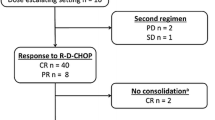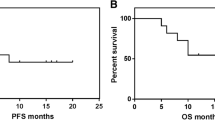Abstract
We performed a retrospective analysis of patients with diffuse large B cell lymphoma treated with rituximab plus CHOP (cyclophosphamide, adriamycin, vincristine and prednisone) as a first-line therapy at 22 hospitals of the Kyushu Lymphoma Study Group. During the period 1996–2005, 1,057 patients (aged 22–90 years) were analyzed. Of these, 678 were treated with CHOP, and 379 were treated with rituximab plus CHOP (R-CHOP). The complete response rate was 59.9% in the CHOP group and 67.0% in the R-CHOP group (P < 0.001). Three-year progression-free survival (PFS) and overall survival (OS) rates were significantly higher in the R-CHOP group than in the CHOP group (61.3 vs. 45.6% for PFS, P < 0.001; 68.3 vs. 54.5% for OS, P < 0.001). The International Prognostic Index was a good prognostic marker for both groups; a survival benefit of rituximab addition was found for each risk subgroup and also for both age groups (≤60 and >60 years). Among 345 patients who received localized radiation therapy, the adding rituximab to CHOP attenuated the survival difference between CHOP and R-CHOP groups (P = 0.104), compared with no radiation group (P < 0.001). Results of this large-scale, multicenter study confirm that rituximab plus CHOP provided a greater survival benefit than CHOP alone.





Similar content being viewed by others
References
Fisher RI, Miller TP, O’Connor OA. Diffuse aggressive lymphoma. Hematol Am Soc Hematol Educ Progr. 2004;1:221–36.
The Research Group for Population-based Cancer Registration in Japan. Cancer incidence and incidence rates in Japan in 1995: estimates based on data from nine population-based cancer registries. The Research Group for Population-based Cancer Registration in Japan. Jpn J Clin Oncol. 2000;30:318–21.
Izumo T, Maseki N, Mori S, Tsuchiya E. Practical utility of the revised European–American classification of lymphoid neoplasms for Japanese non-Hodgkin’s lymphomas. Jpn J Cancer Res. 2000;91:351–60.
Gordon LI, Harrington D, Andersen J, et al. Comparison of a second-generation combination chemotherapeutic regimen (m-BACOD) with a standard regimen (CHOP) for advanced diffuse non-Hodgkin’s lymphoma. N Engl J Med. 1992;327:342–9.
Fisher RI, Gaynor ER, Dahlberg S, et al. Comparison of a standard regimen (CHOP) with three intensive chemotherapy regimens for advanced non-Hodgkin’s lymphoma. N Engl J Med. 1993;328:1002–6.
Ogura M, Morishima Y, Kagami Y, et al. Randomized phase II study of concurrent and sequential rituximab and CHOP chemotherapy in untreated indolent B-cell lymphoma. Cancer Sci. 2006;97:305–12.
Hiddemann W, Kneba M, Dreyling M, et al. Frontline therapy with rituximab added to the combination of cyclophosphamide, doxorubicin, vincristine, and prednisone (CHOP) significantly improves the outcome for patients with advanced-stage follicular lymphoma compared with therapy with CHOP alone: results of a prospective randomized study of the German Low-Grade Lymphoma Study Group. Blood. 2005;106:3725–32.
Shan D, Ledbetter JA, Press OW. Apoptosis of malignant human B cells by ligation of CD20 with monoclonal antibodies. Blood. 1998;91:1644–52.
Jazirehi AR, Huerta-Yepez S, Cheng G, Bonavida B. Rituximab (chimeric anti-CD20 monoclonal antibody) inhibits the constitutive nuclear factor-{kappa}B signaling pathway in non-Hodgkin’s lymphoma B-cell lines: role in sensitization to chemotherapeutic drug-induced apoptosis. Cancer Res. 2005;65:264–76.
Jazirehi AR, Bonavida B. Cellular and molecular signal transduction pathways modulated by rituximab (rituxan, anti-CD20 mAb) in non-Hodgkin’s lymphoma: implications in chemosensitization and therapeutic intervention. Oncogene. 2005;24:2121–43.
Vega MI, Jazirehi AR, Huerta-Yepez S, Bonavida B. Rituximab-induced inhibition of YY1 and Bcl-xL expression in Ramos non-Hodgkin’s lymphoma cell line via inhibition of NF-kappa B activity: role of YY1 and Bcl-xL in Fas resistance and chemoresistance, respectively. J Immunol. 2005;175:2174–83.
Coiffier B, Lepage E, Briere J, et al. CHOP chemotherapy plus rituximab compared with CHOP alone in elderly patients with diffuse large-B-cell lymphoma. N Engl J Med. 2002;346:235–42.
Pfreundschuh M, Trumper L, Osterborg A, et al. CHOP-like chemotherapy plus rituximab versus CHOP-like chemotherapy alone in young patients with good-prognosis diffuse large-B-cell lymphoma: a randomised controlled trial by the MabThera International Trial (MInT) Group. Lancet Oncol. 2006;7:379–91.
Feugier P, Van Hoof A, Sebban C, et al. Long-term results of the R-CHOP study in the treatment of elderly patients with diffuse large B-cell lymphoma: a study by the Groupe d’Etude des Lymphomes de l’Adulte. J Clin Oncol. 2005;23:4117–26.
Habermann TM, Weller EA, Morrison VA, et al. Rituximab-CHOP versus CHOP alone or with maintenance rituximab in older patients with diffuse large B-cell lymphoma. J Clin Oncol. 2006;24:3121–7.
Sehn LH, Donaldson J, Chhanabhai M, et al. Introduction of combined CHOP plus rituximab therapy dramatically improved outcome of diffuse large B-cell lymphoma in British Columbia. J Clin Oncol. 2005;23:5027–33.
Cheson BD, Horning SJ, Coiffier B, et al. Report of an international workshop to standardize response criteria for non-Hodgkin’s lymphomas NCI Sponsored International Working Group. J Clin Oncol. 1999;17:1244.
Jaffe ES, Harris NL, Stein H, Vardiman J. Pathology and genetics of tumors of the hematopoietic and lymphoid tissues. Lyon: IARC Press; 2001. p. 171–4.
Saito B, Shiozawa E, Usui T, et al. Rituximab with chemotherapy improves survival of non-germinal center type untreated diffuse large B-cell lymphoma. Leukemia. 2007;21:2563–6.
Nishimori H, Matsuo K, Maeda Y, et al. The effect of adding rituximab to CHOP-based therapy on clinical outcomes for Japanese patients with diffuse large B-cell lymphoma: a propensity sore matching analysis. Int J Hematol. 2009;89:326–31.
Hermine O, Haioun C, Lepage E, et al. Prognostic significance of bcl-2 protein expression in aggressive non-Hodgkin’s lymphoma. Groupe d’Etude des Lymphomes de l’Adulte (GELA). Blood. 1996;87:265–72.
Ichikawa A, Kinoshita T, Watanabe T, et al. Mutations of the p53 gene as a prognostic factor in aggressive B-cell lymphoma. N Engl J Med. 1997;337:529–34.
Yamaguchi M, Seto M, Okamoto M, et al. De novo CD5+ diffuse large B-cell lymphoma: a clinicopathologic study of 109 patients. Blood. 2002;99:815–21.
Seki R, Okamura T, Koga H, et al. Prognostic significance of the F-box protein Skp2 expression in diffuse large B-cell lymphoma. Am J Hematol. 2003;73:230–5.
Seki R, Ohshima K, Fujisaki T, et al. Prognostic significance of S-phase kinase-associated protein 2 and p27kip1 in patients with diffuse large B-cell lymphoma: effects of rituximab. Ann Oncol. 2009 (in press).
Lossos IS, Morgensztern D. Prognostic biomarkers in diffuse large B-cell lymphoma. J Clin Oncol. 2006;24:995–1007.
Sehn LH, Berry B, Chhanabhai M, et al. The revised International Prognostic Index (R-IPI) is a better predictor of outcome than the standard IPI for patients with diffuse large B-cell lymphoma treated with R-CHOP. Blood. 2007;109:1857–61.
Mounier N, Briere J, Gisselbrecht C, et al. Rituximab plus CHOP (R-CHOP) overcomes bcl-2-associated resistance to chemotherapy in elderly patients with diffuse large B-cell lymphoma (DLBCL). Blood. 2003;101:4279–84.
Nyman H, Adde M, Karjalainen-Lindsberg ML, et al. Prognostic impact of immunohistochemically defined germinal center phenotype in diffuse large B-cell lymphoma patients treated with immunochemotherapy. Blood. 2007;109:4930–5.
Seki R, Ohshima T, Fujisaki T, et al. Prognostic impact of immunohistochemical biomarkers in diffuse large B-cell lymphoma in the rituximab era. Cancer Sci. 2009;100:1842–7.
Miller TP, Dahlberg S, Cassady JR, et al. Chemotherapy alone compared with chemotherapy plus radiotherapy for localized intermediate- and high-grade non-Hodgkin’s lymphoma. N Engl J Med. 1998;339:21–6.
Reyes F, Lepage E, Ganem G, et al. ACVBP versus CHOP plus radiotherapy for localized aggressive lymphoma. N Engl J Med. 2005;352:1197–205.
Persky D, Unger J, Spier C, et al. Phase II study of rituximab plus three cycles of CHOP and involved-field radiotherapy for patients with limited stage aggressive B-cell lymphoma: Southwest Oncology Group Study 0014. J Clin Oncol. 2008;26:2258–62.
Milpied N, Deconinck E, Gaillard F, et al. Initial treatment of aggressive lymphoma with high-dose chemotherapy and autologous stem-cell support. N Engl J Med. 2004;350:1287–95.
Acknowledgments
This study was performed in collaboration with the many hematologists and pathologists associated with the Kyushu Lymphoma Study Group. We express our appreciation to all of them.
Author information
Authors and Affiliations
Corresponding author
Appendix: Kyushu Lymphoma Study Group
Appendix: Kyushu Lymphoma Study Group
Division of Hematology and Oncology, Department of Medicine, Kurume University School of Medicine: Ritsuko Seki, Koji Nagafuji, Ken Tanaka, Takashi Okamura; Department of Pathology, Kurume University School of Medicine: Konomi Takasu, Kennosuke Karube, Koichi Ohshima; Department of Internal Medicine, Matsuyama Red Cross Hospital: Tsuyoshi Muta, Tomoaki Fujisaki; Department of Hematology, National Kyushu Cancer Center: Ilseung Choi, Naokuni Uike; Department of Internal Medicine, National Hospital Organization Kumamoto Medical Center: Michihiro Hidaka, Toshihiko Murayama, Fumio Kawano; Department of Internal Medicine, Saga Prefectural Hospital, Koseikan: Eijyou Matsuishi, Fumio Yamasaki, Hisashi Gondo; Department of Internal Medicine, Miyazaki Prefectural Hospital: Noriaki Kawano, Shigeyoshi Makino, Toru Hayashi; Department of Hematology, Hamanomachi Hospital: Tetsuya Eto, Shinichi Aishima; Department of Hematology, Sasebo City General Hospital: Yukiyoshi Moriuchi; Department of Hematology, Iizuka Hospital: Fumihiro Taguchi; Department of Hematology, Harasanshin General Hospital: Tomohiko Kamimura, Shinji Kouno; Division of Clinical Hematology, Kumamoto City Hospital: Hiroyuki Tsuda, Nobuyuki Arima; Shimonoseki City Central Hospital: Ryosuke Ogawa; Department of Internal Medicine, Gastroenterology and Hematology, Faculty of Medicine, Miyazaki University: Kazuya Shimoda, Kiyoshi Yamashita; Department of Internal Medicine, Koga General Hospital: Keiko Suzuki; Department of Internal Medicine, NTT Nishinippon Kyushu General Hospital: Hitoshi Suzushima; Molecular Medicine Unit and Hematology, Atomic Bomb Disease Institute, Nagasaki University Graduate School of Biomedical Sciences: Kunihiro Tsukazaki, Masao Tomonaga; Department of Internal Medicine, Kyushu Kosei-nenkin Hospital: Masakazu Higuchi; Department of Hematology, Imamura Bun-in Hospital: Atae Utsunomiya; Department of Internal Medicine, Saiseikai-Hita Hospital: Masahiro Iwahashi; Department of Medicine and Bioregulatory Science, Graduate School of Medical Science, Kyushu University: Yasunobu Abe; Department of Hematology, Imamura Hon-in Hospital: Toshimasa Kukita, Tadashi Matsumoto; Japanese Red Cross Kumamoto Health Care Center: Minoru Yoshida; First Department of Internal Medicine, Faculty of Medicine, Fukuoka University: Junji Suzumiya, Kazuo Tamura; Department of Hematology, St. Mary’s Hospital: Hiroto Jyoujima, Koichi Higaki, Yutaka Imamura; Department of Medicine and Biosystemic Science, Kyushu University Graduate School of Medical Science: Naoki Harada, Mine Harada; Fukuoka Teishin Hospital: Tsunefumi Shibuya; Fukuoka Higashi Medical Center: Mika Kuroiwa; Department of Internal Medicine, Kitakyushu Municipal Medical Center: Yuji Ohno; Internal Medicine, Saga University: Eisaburo Sueoka; Department of Internal Medicine, Karatsu Red Cross Hospital: Masaharu Miyahara; National Hospital Organization Miyakonojo Hospital: Maeda Koichi; Department of Hematology, Kumamoto University School of Medicine: Fumihiko Matsuno; Department of Hematological and Immunological Medicine, Kagoshima University Hospital: Kimiharu Uozumi; Division of Endocrinology and Metabolism, Faculty of Medicine, University of Ryukyus: Masato Masuda.
About this article
Cite this article
Seki, R., Ohshima, K., Nagafuji, K. et al. Rituximab in combination with CHOP chemotherapy for the treatment of diffuse large B cell lymphoma in Japan: a retrospective analysis of 1,057 cases from Kyushu Lymphoma Study Group. Int J Hematol 91, 258–266 (2010). https://doi.org/10.1007/s12185-009-0475-2
Received:
Revised:
Accepted:
Published:
Issue Date:
DOI: https://doi.org/10.1007/s12185-009-0475-2




